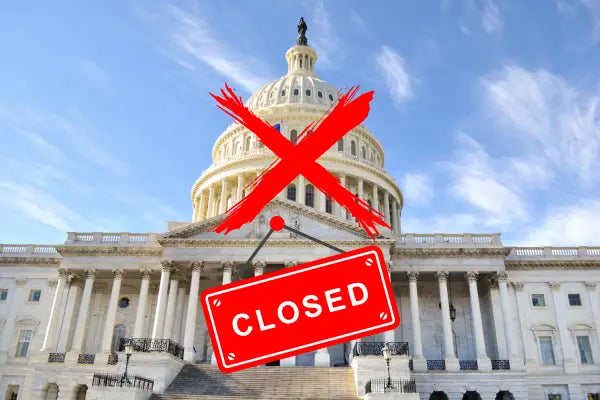Understanding the U.S. Government Shutdown 2025
A government shutdown occurs when Congress does not pass the necessary funding bills. This stops many federal government activities. The current shutdown began in October 2025. It affects many parts of daily life for Americans.
What is a Government Shutdown?
A shutdown means the government cannot spend money without approved funding. Many government offices close during this time. Essential services may still operate but with limited staff.
- Federal employees may be furloughed or work without pay.
- Government programs can be paused or slowed.
When Did the Current Shutdown Begin?
The current shutdown started on October 1, 2025, the start of the new fiscal year. This happened because Congress did not pass a budget on time. Negotiations are ongoing but stalled.
- The shutdown marks the first in over a year.
- It affects a wide range of government services and workers.
Why Budget Disagreements Lead to Shutdowns
Congress controls the budget and must agree on spending. Without agreement, government programs lose funding. This causes shutdowns. Political differences make this process challenging.
The Role of Congress in Funding
Congress passes spending bills to fund government work. Both the House and Senate must agree. If they do not, government operations stop.
- The budget process happens yearly.
- Disagreements delay funding decisions.
Partisan Differences in Spending Plans
Parties often disagree on how much to spend and where to cut costs. These differences lead to hold-ups in budgeting. Using policy goals in budget talks makes agreement harder.
- Democrats and Republicans have different priorities.
- Timing and strategy affect negotiations.
Key Issues Causing the 2025 Shutdown
The current shutdown involves debates on health care and spending levels. Leaders disagree on specific funding allocations. Political dynamics have increased tensions.
Health Insurance and Medicaid Debates
Democrats want to keep health programs funded like Medicaid. Republicans want to reduce spending in these areas. This difference blocks agreement.
- Some want to extend health insurance subsidies.
- Others seek cuts in Medicaid and related programs.
Requests for a Clean Funding Bill
Republicans prefer a simple spending bill to keep the government running. Democrats want to include policy changes. This disagreement has stopped the budget process.
- A clean bill avoids new policies or cuts.
- Political aims complicate the decision.
The Impact on Federal Employees

Many federal workers face furloughs or unpaid work. This affects families and communities. Some essential workers continue with delayed pay.
Furloughs and Unpaid Work
About 800,000 employees are furloughed, meaning no work or pay. Another 700,000 work but do not get paid yet. This causes financial stress for many households.
- Furloughed workers receive back pay later.
- Work continues for key operations like safety and health.
Effect on Daily Government Services
Services like processing applications or support programs slow down. Some offices close to the public. This increases wait times and delays.
- Public-facing services are reduced.
- Grant and loan approvals may pause.
Political Actions Around Funding
The shutdown has political moves affecting funding. Some decisions impact local projects and leadership. The situation increases tensions between parties.
Infrastructure Funding Freeze
The White House froze $18 billion in infrastructure funds for cities. This affected key projects and political leaders in places like New York City.
- This funding supports bridges, roads, and transit projects.
- Freezing funds delays local improvements.
Blame Between Political Parties
Both sides blame each other for the shutdown. Democrats say Republicans refuse to fund the government. Republicans say Democrats block necessary bills.
- This blame affects public opinion.
- Political pressure aims to end the impasse.
What Happens Without a Funding Agreement?

Without a budget deal, the government remains closed. Essential services work with limits. Many programs and projects are delayed.
Government Services Halt
Nonessential offices close. Some services stop completely. Others operate with fewer staff.
- Examples: Parks, museums, and some social services close temporarily.
- Emergency and military services continue.
Public Projects Delay
Projects relying on federal funding pause. This causes delays in local improvements. Communities may see less progress.
- Construction and infrastructure projects slow.
- Grants and funding to states may stall.
How Congress Tries to End Shutdowns

Congress meets to negotiate budgets. They try passing short-term funding bills. Sometimes these efforts succeed; other times they fail.
Negotiation Efforts
Party leaders meet privately to discuss terms. They try to find common ground. Talks aim to end funding fights.
- Negotiations include both chambers of Congress.
- Progress depends on party willingness to compromise.
Attempts at Clean Continuing Resolutions
They try passing simple spending bills to avoid shutdowns. These bills fund the government temporarily. They avoid adding new policies that cause disagreement.
- Known as continuing resolutions or CRs.
- Used to buy more time for budget talks.
The Economic Effects of a Shutdown
Shutdowns affect workers and the economy. Delayed pay causes hardship. Broader effects can slow growth and spending.
Impact on Federal Workers’ Income
Federal workers may miss paychecks or face uncertainty. This reduces their spending power. Some depend on loans or savings during shutdowns.
- Back pay is usually given when the shutdown ends.
- Financial stress can grow with longer shutdowns.
Broader Economic Concerns
Consumer confidence falls during shutdowns. Businesses may see less spending. The government’s role in the economy is important.
- Markets watch for quick resolutions.
- Long shutdowns can ripple through the economy.
The Role of the President in Shutdowns
The President plays a key role in budget talks. The administration sets priorities for funding. Sometimes shutdowns are used as political tools.
Executive Decisions
The President can push for budget cuts or spending increases. The executive branch works with Congress on negotiations. Leadership shapes the shutdown outcome.
- Presidential statements can influence talks.
- Decisions affect funding for many programs.
Use of Shutdown as a Political Tool
Sometimes, shutdowns are part of a larger strategy. They may pressure Congress to accept certain demands. This makes budgets harder to pass.
- Political parties use leverage during fights.
- Public opinion can sway negotiations.
Public Reactions to the Shutdown

Public views vary on government funding issues. Many worry about the impact on services and workers. Others focus on political blame.
Concerns from Affected Workers
Federal employees fear lost wages and job security. Uncertainty affects families and plans. Support networks may help during this time.
- Furloughed workers often share their experiences.
- Some turn to temporary jobs or assistance.
Citizen Views on Government Funding
People have different ideas about spending priorities. Some want more funding; others want cuts. Public opinion shifts with news and discussions.
- Community groups may voice concerns.
- Local leaders explain the shutdown effects.
Resources for Tracking Shutdown Updates
It is helpful to follow current news and official websites. These give updates on the budget talks and government status. Reliable sources help understand changes.
Official Government Websites
The official government shutdown information page provides timely updates and resources. It explains what is open and what is closed during shutdowns.
- Check for updates on federal services.
- Learn about what programs continue.
News Outlets Covering Funding Talks
Trusted news sites report on budget negotiations. They explain decisions and their impacts. Follow them to stay informed during shutdowns.
- Look for fact-checked coverage.
- Avoid misinformation by relying on known sources.
Summary of the Shutdown Situation
The government shuts down when funding agreements end without approval. This affects workers, services, and projects across the U.S. Talks continue, but disagreements keep the shutdown ongoing.
The Importance of Budget Agreement
Agreeing on a budget is key to keeping government running smoothly. Funding ensures people get paid and projects move forward. Without it, disruptions happen.
- The budget supports many daily activities and services.
- Delays affect millions of Americans.
The Current Standstill
The 2025 shutdown continues because parties differ on spending plans and policies. Negotiations are ongoing, but no deal has been reached yet.
- Both political sides are firm on key points.
- Public pressure may influence future talks.
To learn more about government budgeting, visit the official Congress website. For details on how services are affected, see the Federal Register site. For clear explanations of the budget process, check the Institute of Public Administration.
Frequently Asked Questions About the 2025 U.S. Government Shutdown
This section answers key questions many Americans have about the ongoing government shutdown. We've gathered common concerns to help you understand what is happening and how it might affect you.
- Details about federal services during the shutdown
- Impacts on workers and benefits
- Political causes and potential resolutions
- What to expect in the coming weeks
What exactly causes a government shutdown?
A government shutdown happens when Congress fails to pass funding bills by the deadline. Without an approved budget or temporary funding (a continuing resolution), many federal agencies must stop non-essential operations.
The current 2025 shutdown was caused by disagreements over budget priorities, health care funding, and spending levels between parties.
How long can the current government shutdown last?
The length depends on negotiations in Congress and the White House. Past shutdowns have lasted from a few days to over a month. Experts suggest it may continue into mid-October or beyond if disagreements persist.
Political strategies and public pressure influence the duration greatly.
Which federal services remain open during the shutdown?
Essential services like national security, air traffic control, and Social Security continue to operate. But many nonessential activities pause, including national parks, food inspections, and museums.
- Mail delivery and student loans continue.
- Delays may happen in other government functions.
- Emergency services are unaffected.
Are federal employees paid during the shutdown?
Most federal employees are furloughed without pay during a shutdown. However, after the shutdown ends, they typically receive back pay. Some essential workers continue to work but may experience delayed paychecks.
- Financial hardship is common for furloughed workers.
- Back pay is not guaranteed until new funding is approved.
How does the shutdown affect Social Security and Medicare?
Social Security and Medicare benefits generally continue because these programs are funded separately through mandatory spending. However, some related administrative services may slow down.
- Benefit payments are not stopped.
- Customer service offices may have reduced hours.
What impact does the shutdown have on government contractors?
Government contractors may face payment delays and paused projects. Some contracts are suspended until funding is restored, which can impact businesses relying on federal work.
- Contractors usually don’t receive back pay.
- Uncertainty affects project planning and staffing.
Can the shutdown affect military operations?
Active military personnel continue working and receive pay. However, some civilian defense workers may be furloughed. Training and non-essential functions could be delayed.
- Troops remain deployed as needed.
- Contractor support may see interruptions.
What happens to federal aid programs during the shutdown?
Mandatory aid programs like SNAP (food stamps) generally continue as they rely on separate funding. Some discretionary assistance may be paused or delayed depending on the situation.
- Benefit distribution usually continues.
- Administrative delays are possible.
How does the shutdown affect immigration services?
Some immigration services continue because they have dedicated funding, such as visa and citizenship processing. But other parts like casework and enforcement may slow down or pause.
- Hiring for immigration may be delayed.
- Some applications may take longer.
What does the shutdown mean for public health and safety?
Essential health services operate, but some programs experience staff shortages. Disease monitoring and food inspections may be reduced, potentially affecting public safety.
- Emergency responses continue.
- Regular inspections could be delayed.
Who is responsible for the government shutdown?
Responsibility is often debated politically. Currently, both Democrats and Republicans hold differing views on causes. Voters and experts see shared fault due to lack of agreement on budget issues.
- Budget conflicts and policy demands contribute.
- Both parties aim to sway public opinion.
What is a Continuing Resolution and how does it relate to shutdowns?
A Continuing Resolution (CR) is a temporary funding measure to keep the government running when a full budget isn’t agreed. Passing a CR typically prevents shutdowns by providing short-term funding.
- CRs avoid service disruptions temporarily.
- Failing to pass a CR leads to shutdowns.
Can a shutdown lead to a government default?
A shutdown is different from a default. A government default happens if Congress doesn't raise or suspend the debt ceiling. Shutdowns stop spending temporarily, but default affects national credit and borrowing.
- Shutdown delays discretionary spending.
- Defaults have wider economic risk.
How does a shutdown affect the economy overall?
Shutdowns can slow economic growth by reducing government spending and worker incomes. Consumer confidence may drop and some industries see delays in permits and contracts.
- Short shutdowns have limited long-term damage.
- Long shutdowns increase risks to jobs and markets.
What are the signs that a shutdown is about to end?
Progress in budget talks or agreement on a Continuing Resolution are key signs. Public pressure and market reactions may prompt lawmakers to reach a deal. Official announcements follow when funding is approved.
- Increase in bipartisan negotiations.
- Passing votes in House and Senate.
Are there legal limits on how long a shutdown can last?
No specific legal limit exists on shutdown duration. It lasts until Congress and the President agree on funding. Past shutdowns have lasted from days to over a month, depending on political factors.
- Length depends on negotiations, not law.
- Public and political pressure usually ends it.
How can citizens stay informed during a shutdown?
Official government websites and trusted news sources provide updates on services and budget talks. Following multiple outlets helps get a clear picture of the situation.
- Check usa.gov for official news.
- Monitor major news networks and local reports.
- Use social media with caution due to misinformation.
What personal steps can individuals take during a shutdown?
People should plan for delays in government services, budget for possible income gaps, and know which services continue. Stay informed about benefits or programs you use.
- Contact agencies to check service availability.
- Prepare financially for uncertain pay schedules.
- Look for community support if needed.
How might a shutdown affect local governments?
Local governments may face delays in federal grants and funding, slowing projects and services. Some may increase local taxes or cut spending to cover gaps.
- Infrastructure projects can pause.
- Social service programs may be impacted.
Can a government shutdown affect voting or elections?
Shutdowns generally do not stop elections but can slow related government operations. Voter registration or election administration could face delays if funding is affected.
- Essential electoral functions continue.
- Local election offices may experience disruptions.
Do shutdowns affect federal retirement benefits?
Benefits such as pensions usually continue because they are funded separately. However, processing new claims or changes may be delayed.
- Payments continue as scheduled.
- Administrative services may slow down.
Will the shutdown affect federal tax refunds?
Generally, tax refunds continue because the IRS is funded through fees and mandatory spending. However, delays in processing may occur if staffing is reduced.
- Electronic filing typically remains available.
- Paper refund processing may slow down.
How does the shutdown affect veterans' benefits?
Veterans’ benefits are considered mandatory spending and usually continue. Some services and new claims processing may face delays.
- Benefit payments remain on schedule.
- Customer service centers might have limited hours.
Are passport and visa services impacted during the shutdown?
Some passport and visa processing continues as it is funded through fees. However, new applications may see delays depending on staffing.
- Renewals might be prioritized over new applications.
- Emergency passport services usually continue.
What happens to federal student loan processing?
Student loan payments and services continue, but some support functions may slow. New applications and approvals might take longer.
- Payments are still collected on time.
- Customer support may be limited.
Does the shutdown affect national parks and monuments?
Many national parks close to the public during shutdowns or operate with limited services. Visitor centers, tours, and maintenance activities may stop.
- Some parks remain partially open for essential services.
- Fees and reservations might be suspended.
How are federal law enforcement agencies affected?
Essential law enforcement operations continue during a shutdown. Some civilian support roles may be furloughed but frontline officers keep working.
- Security in federal buildings remains active.
- Investigations may slow due to reduced support staff.
What about air travel and TSA security during a shutdown?
Air travel and security staff remain active. TSA agents work but might face delayed pay. Airport operations continue to ensure safety.
- Longer security lines possible due to staffing shortages.
- Payments usually catch up after shutdown ends.
Can a government shutdown affect military benefits for dependents?
Benefits for military families continue, including healthcare and education aid. Processing of some new applications may slow during funding lapses.
- Service member pay is unaffected.
- Dependents’ support programs try to maintain services.
How are public health labs and research affected?
Some research projects funded by discretionary budgets may pause. Public health labs may reduce testing or data collection temporarily.
- Emergency public health efforts continue.
- Non-urgent studies may be delayed.
Are food safety inspections impacted by the shutdown?
Routine inspections may slow or pause, but high-risk inspections for food safety continue. This may slightly increase risks related to foodborne illnesses.
- FDA and USDA handle priority work.
- Consumer safety remains a focus despite cuts.
Does the shutdown influence federal research grants?
New grant approvals often pause during shutdowns. Existing grants typically continue unless funding is exhausted or delayed.
- Researchers may face delays in funding decisions.
- Grant applications might experience longer review times.
How does the shutdown affect disaster response funding?
Emergency disaster response funding is usually protected, but some administrative tasks may slow. Post-disaster recovery programs may face delays in processing aid.
- Emergency aid continues for ongoing crises.
- New applications for aid might delay.
What support is available for furloughed federal workers?
Some local organizations offer financial and emotional support. Unemployment benefits may be available depending on state laws, though federal guidelines vary.
- Temporary assistance programs exist in many states.
- Community groups often provide food and counseling.
Are national museums and cultural institutions open?
Many national museums close during shutdowns, halting tours and events. Essential maintenance staff may remain on site but public access is shut down.
- Some museums operated by nonprofits may open independently.
- Special exhibitions and programs are often canceled.
Will shutdowns affect federal court operations?
Essential court operations typically continue, but some administrative work and non-urgent cases may be delayed. Public access to courts could be limited.
- Criminal cases proceed as scheduled.
- Civil cases might face scheduling changes.
How does the shutdown impact federal lawmaking and oversight?
Congress continues to meet, but some support staff and oversight activities may be reduced. Committee hearings might slow down depending on funding.
- Legislative work is prioritized for critical laws.
- Research and analysis staff may face furloughs.
Are there any protections for businesses working with the government?
Businesses might face payment delays, but contracts are usually protected once funding is restored. Many contracts include clauses for such events.
- Contractors must monitor government funding status.
- Some relief programs may assist affected businesses.
Does the shutdown affect state government budgets?
State governments receive federal funds that may be delayed, affecting projects and programs. States may need to adjust their spending plans temporarily.
- Federal grant timing is crucial for state budgets.
- States may use reserves or loans to cover gaps.
What is the role of the Senate during a shutdown?
The Senate debates and votes on funding bills and resolutions to end shutdowns. Senators also negotiate with the House and the President to reach budget agreements.
- Senators can hold key votes that determine funding.
- Leadership works to build bipartisan support.
Can the public influence ending a government shutdown?
Public opinion can put pressure on lawmakers to find a solution. Calling representatives and participating in civic discussions helps keep the issue visible.
- Voter voices and protests matter.
- Media coverage shapes public awareness.
Quick Summary of the 2025 U.S. Government Shutdown and What You Need to Know
This blog breaks down the government shutdown happening in 2025, explaining why it started and how it affects everyday life. It covers key topics about federal services, workers, and the political causes behind the funding delays.
If short on time, here are the main points:
- What a government shutdown means and when the 2025 shutdown began
- Why Congress and the President disagree on federal spending
- How government employees and federal programs are affected
- Which services continue during the shutdown
- Common questions and concerns from the public
If this sparked your interest, feel free to explore our collection of helpful resources and products tailored to keep you informed and prepared. We’d love to hear your thoughts or experiences with this shutdown, so please leave a comment or question to keep the conversation going!






0 comentarios